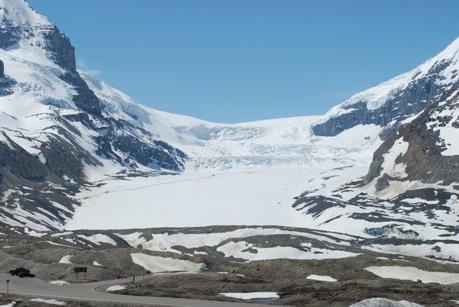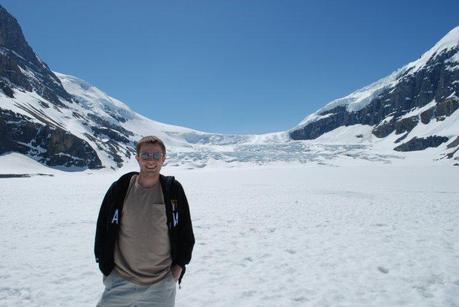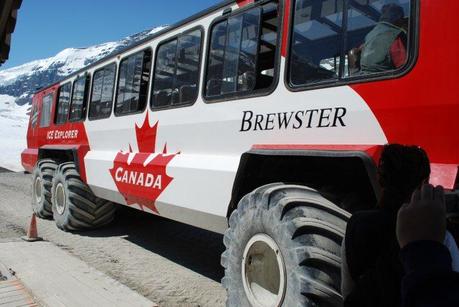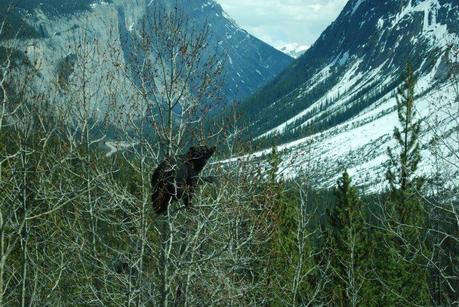 Back in 2010 I had finally got enough reward miles for a frequent flyer ticket anywhere in the USA and Canada. Naturally I booked one of the most expensive tickets that I could get my hands on, and ended up on a short trip to Banff National Park in Alberta, Canada. Between the stunning vistas of Lake Louise and the gorgeous hikes near Banff National Park, I could easily see why this park is one my Canadian friends are most proud of. While in Lake Louise, I decided to take a day trip further north, almost to the entrance of nearby Jasper National Park to explore the Columbia Icefields. After plunking down $150 for the day trip I boarded the coach in the early morning to see what the icefields were all about.
Back in 2010 I had finally got enough reward miles for a frequent flyer ticket anywhere in the USA and Canada. Naturally I booked one of the most expensive tickets that I could get my hands on, and ended up on a short trip to Banff National Park in Alberta, Canada. Between the stunning vistas of Lake Louise and the gorgeous hikes near Banff National Park, I could easily see why this park is one my Canadian friends are most proud of. While in Lake Louise, I decided to take a day trip further north, almost to the entrance of nearby Jasper National Park to explore the Columbia Icefields. After plunking down $150 for the day trip I boarded the coach in the early morning to see what the icefields were all about. Shortly after starting the day, we were given the typical brief about the day's itinerary. As I hadn't researched much about this day trip before booking it, I was pretty shocked to find out that I wouldn't be seeing much of the Columbia Icefield at all. You can imagine the number of emotions I had going through my head that I had just spent $150 on a day trip to go to an icefield and would not actually be exploring the icefield itself, nor the fact that this was the only one of my Canada Trips that was for pleasure. But as the driver went on to explain, I began to understand.
But if we are not going to see the icefield, what do you see, and what is an icefield anyway?
Icefield vs Glacier

An icefield is quite literally what the name implies, a large field of ice built up over the centuries. The Columbia Icefield is roughly 325 square kilometers and covers a large area of Alberta between Banff and Jasper National Parks. Think of it as what you would expect the icy surfaces of Greenland or Antarctica to look like, with ice that seems to be never ending as far as the eye can see. But you will not be seeing much of it on your day trip.
What you actually get to see and explore at the Columbia Icefields is not the icefields itself, but rather the Athabasca glacier. Glaciers at the Columbia Icefield region are the overflow of the massive icefield that are found rolling (very slowly) over the nearby ridges. As the icefield builds up in height due to annual snow fall, the overflow passes over the surrounding low points in the mountains in the form of moving glaciers. The ice is constantly overflowing as preciptation comes in, and the glacier is pushed out into the valley at a slow pace every year. As the outpouring of ice is still a rather large quantity, it is quite difficult to make it past the glacier to actually get into the icefield, so only the most adventurous (and those willing to pay for it) can make the arrangements to do so.
Those who want to catch a glimpse at the true ice field have two options. The first is to take a helicopter ride over the Icefield while the second is a trekking expedition up the glacier complete with skis and a guide. But be warned, trekking up the glacier to the point of the Icefields is dangerous, challenging, and not for those who are not the most experienced. If you are looking for a glimpse of the Ice Fields themselves, you better charter a helicopter as the safer alternative!
Walking on a Glacier

While you do not go to the icefield proper on the day trip, getting up close and personal with the Athabasca glacier is a rather neat experience, if not just a bit forced because of how regimented the trip is. Rather than hiking on the glacier yourself, you load up in customized ice rovers that follow a set path to take you up onto the glacier about halfway up. Normal vehicles are not equipped to drive on the ice and would also cause significant damage if they did so. The large moving vehicles with trained operators are there to minimize the danger and wear and tear on the glacier by bringing people onto it.
When on the glacier, there isn't much to do. But you are walking on a glacier! Between an impromptu snowball fight or the invariably slips, trips, and falls, you will be sure that the glacier walk is a unique experience. If anything, the experience is worth it just for this moment, and it is certainly a surreal one when you stop for a minute to take it all in.
The Retraction of the Glacier
One of the interesting things you'll see when exploring the visitors center of the Columbia Ice Fields while waiting to go up the glacier is the time lapse images of the glacier over the last 100 years. Due to the warming of the region as a result of the climate change in the last century, the Athabasca glacier at the Columbia Ice Fields has shrunk by half its volume and receded over a full kilometer. The pictures are both awe inspiring and disturbing as you can visibly see how much larger the glacier was just 100 years ago. When thinking of it, the day trip was worth this solemn thought at how much a natural beauty can fade in such a relatively short period of time. Moral of the story? Go see it now, because the Columbia Icefield will not be here forever!
The Added Perk - The Drive

When talking about a day trip from the Columbia Icefields from Banff or Lake Louise (where I was), you'd be hard pressed to not mention the drive to and from the icefields themselves. The stretch of highway connecting your two destinations is almost worth the price of the day trip itself. Why? Well between rising over and under mountains for over an hour, the scenery is beautiful. The trees change, at points disappear entirely due to the elevation, plains come and go, an occasional dust devil in a field nearby, or if you are really lucky, a black bear! Suffice it to say, this is one drive you shouldn't doze off on!
So is the day trip from Banff or Lake Louise and the $150+ cost worth it? That is up to you. Those who have a rental car would definitely enjoy driving up and visiting the Athabasca Glacier even if it is from the distance of the visitors center and no admission charge. Those without a car will certainly be paying a premium for the transit from town to the site, but also get to enjoy going all the way up the glacier and experiencing something few people can say they've ever done - walk on a glacier!

